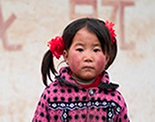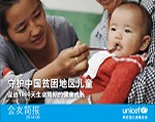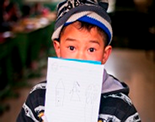By Liu Sijia, UN volunteer
When news of four young siblings living alone committed suicide in Guizhou Province emerged in June, the nation seemed shaken. Although the children had been left with sufficient funds in the family bank account by their father who migrated for greater income opportunities elsewhere, the four deaths triggered a new spotlight on the needs of all children in poverty—some for whom monetary poverty may be less of a deprivation than lack of stable and loving care—even where parents remain in the home.
What do their deaths say about what children who are poor need most?
In most countries, children are more likely to be trapped in poverty than adults. A 2009 World Bank report characterized the poverty incidence of children younger than 16 years as high, at about 16 per cent for boys and 17 per cent for girls. China's poverty threshold was set at 2,300 yuan ($362) a year in 2011, which was similar to the then international standard of US $1.25 a day[1]. According to the National Bureau of Statistics, 70.17 million people in the country qualify as poor.
Children additionally experience poverty differently from adults. As defined by UNICEF, children living in poverty refer to those who experience deprivation of the material, spiritual and emotional resources needed to survive, develop and thrive, leaving them unable to enjoy their rights, achieve their full potential or participate as full and equal members of society. Under United Nations Resolution 61/146 on the Rights of the Child, children living in poverty are those deprived of nutrition, water and sanitation facilities, access to basic health care, shelter, education, participation, protection, needed goods and services.
To better understand the situation of child poverty in China and thus how to help the most disadvantaged children, UNICEF and the State Council Leading Group of Poverty Alleviation and Development launched in 2013 the China Child Poverty Analysis in Hubei Province, where the largest population of excluded and disadvantaged children are concentrated across four regions (covering a large number of impoverished counties where an estimated 5 million people live in poverty, 61 per cent of them in absolute poverty). Hubei Province was chosen because the distinct poverty characteristics of those four regions are representative of the whole country.
Based on a series of dimensions and indicators for evaluating children's basic survival and development, the multidimensional poverty analysis was designed to create a child poverty profile of children living in Hubei. The indicators cover eight dimensions: nutrition, health, education, information, water, sanitation, housing and protection.
This profile is expected to inform the provincial government on children's needs and thus create more targeted and responsive poverty reduction policies and programmes.
Thus far, the analysis has found that children in poverty experience the severest deprivation in the dimensions of sanitation, nutrition and safe drinking water. For instance, 65 per cent of children in Hubei Province do not have access to clean sanitation facilities; only 36 per cent have access to a flush toilet; nearly 58 per cent of children use a dry pit latrine; slightly more than 1 per cent of children live in households without a toilet; and nearly 4 per cent of children do not have household washing facilities.
Among 4,481 surveyed children in Hubei Province, the prevalence rate of mild to moderate anaemia is 33 per cent, of which a staggering 41 per cent live in the Mufu Mountain region. The prevalence rate for children with intellectual disabilities is nearly 9 per cent on average but 11 per cent in the Mufu Mountain region. The prevalence rate of low body weight is also nearly 9 per cent on average but nearly 11 per cent in the Dabie Mountain area. The overall incidence of poor nutrition is nearly 42 per cent.
The analysis has also estimated that nearly 30 per cent of children do not have access to safe drinking water and only drink from an open shallow well or a groundwater source, such as a river, pond or water cello. Some children walk more than 30 minutes to retrieve water. Many households must go outside their village to the nearest accessible well; in these areas, poor water quality has resulted in rampant diseases, such as diarrhoea and enteritis.
The multidimensional child poverty analysis also has discovered severe deprivations among children whose parents had migrated elsewhere, compared with children cared for by both parents (which are estimated at 64 per cent of children in the province). Many children are separated from their mothers, who migrated to a city for work. As the urbanization process continues to deepen, many more mothers are expected to leave their children behind in the hope of gaining more money to support their family.
Although there is no way to know for certain, perhaps the lack of emotional comfort, the absence of family guidance, the lack of protection or mental health care or anomalies in behavioural development may have contributed to the decision of the four children left behind by their migrating father in Guizhou Province to end their lives (their mother had abandoned the family two years earlier).
Among the many insights that have emerged from the expansive look at child poverty in Hubei Province, it is evident that improvements in the care system for impoverished children in rural China includes family comfort, creating support groups among children left behind by migrating parents, neighbourhood support, poverty reduction, psychological counselling and enhanced child welfare and protection services.
The multidimensional child poverty analysis also has revealed differences in deprivations between girls and boys as well as the age at which inequalities start to emerge for different groups of children.
Families that stay together serve the best interest of children. In most countries experiencing rapid urbanization like China, parents migrate with their children.When it is not possible or parents leave because they think it's the best option on behalf of their children, it is essential to strengthen the screening, guidance and supervision of surrogate parents. Additionally, schools and local governments should assign specialized staff members with professional capabilities to monitor and manage and thus better protect all impoverished children, including those left behind in rural households.
"The research in Hubei is timely, considering the Chinese Government included a specific focus on ending child poverty in its 2011–2020 ten-year Rural Poverty Reduction Strategy," says Jillian Popkins, Chief of Social Policy and Reform for Children at UNICEF China. "By filling a gap in our understanding of how children experience poverty, local child poverty analyses can be used to design poverty programmes better suited to ending child poverty in all its forms, once and for all. With around 70 million children—a quarter of China's child population—estimated to be living in rural poverty areas, this work has the potential to make a significant contribution to national development goals and the new international goals for sustainable development."
The research has brought us valuable insights that we hope will help mitigate the impacts of deprivation among all children living poverty in rural China, particularly the tragic incidence of suicide.
UNICEF and the State Council Leading Group of Poverty Alleviation and Development will conduct a similar analysis in Shicheng County, Jiangxi Province.
[1]In October 2015, the World Bank raised the international poverty line to US $1.90 a day.




























